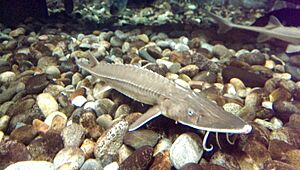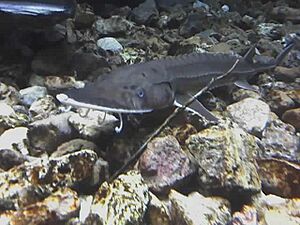Shovelnose sturgeon facts for kids
Quick facts for kids Shovelnose sturgeon |
|
|---|---|
 |
|
| Conservation status | |
| Scientific classification | |
| Synonyms | |
|
The shovelnose sturgeon (Scaphirhynchus platorynchus) is the smallest type of sturgeon living in fresh water in North America. People often call it the hackleback, sand sturgeon, or switchtail. The name "switchtail" comes from a long, thin part on its tail fin, which sometimes breaks off when the fish gets older. These sturgeon are very common in the Missouri River and Mississippi River systems. They used to be caught for food in the United States of America. In 2010, the shovelnose sturgeon was listed as a threatened species. This was because it looks very much like the pallid sturgeon, which is an endangered fish that lives in the same areas.
Contents
What Does a Shovelnose Sturgeon Look Like?
Sturgeon are a special group of fish. They have bony plates, called scutes, along their sides and back. They also have four whisker-like feelers, called barbels, under their snout. These barbels help them find food. There are about 25 different kinds of sturgeon in the world. They live in the northern parts of the world, in oceans, fresh water, or both. People value sturgeon for their meat and for their roe (eggs), which is used to make caviar.
Shovelnose sturgeon can grow up to about 1 metre (39 in) long and weigh up to 4.8 kilograms (11 lb). However, it's more common to see them between 50–85 centimetres (20–33 in) long and weighing around 2.5 kilograms (5.5 lb).
The scientific name Scaphirhynchus means "spade snout" in Greek, and platorynchus means "broad snout." The shovelnose sturgeon has a long, thin part on the top of its tail fin. Its snout is flat and shaped like a shovel. It has four fringed barbels under its snout. These barbels are in a straight line, exactly halfway between its mouth and the tip of its snout. This is different from the pallid sturgeon. The belly of a shovelnose sturgeon is covered with small, scale-like plates. Pallid sturgeon usually have smooth bellies without these plates. Shovelnose sturgeon are usually light brown to buff on top, with a white belly.
Where Do Shovelnose Sturgeon Live?
Shovelnose sturgeon are not bothered much by muddy water. They live in big rivers like the Missouri River and Mississippi River, which often carry a lot of mud and sand. These fish prefer the main, open parts of these rivers. They live on the river bottom, often where the current is fast and the bottom is sandy or gravelly. Like many river fish, shovelnose sturgeon don't stay in one small area. They can travel very long distances.
What Do Shovelnose Sturgeon Eat?
Shovelnose sturgeon eat food from the river bottom. They have a mouth that can stick out, which they use to suck up their food. Their main diet includes the larvae (young forms) of aquatic insects, such as mayflies, true flies (Diptera), and caddisflies. They also eat crustaceans (like small crabs or shrimp), worms, and small fish. Because they feed on the bottom, they can host the larvae of certain freshwater molluscs, like the pimpleback mussel and the yellow sandshell mussel. They are the only known host for the hickorynut mussel.
Shovelnose Sturgeon Life Cycle and Reproduction
Sturgeon usually move from their feeding areas to special breeding areas in large rivers. When they are ready to spawn (lay eggs), their behavior changes, and they might swim closer to the surface. Female sturgeon do not lay eggs every year. Spawning happens over gravel in water that flows fairly quickly. The eggs hatch in about 3 to 5 days. The baby sturgeon, which are about 1 cm long, then drift downstream to good places to grow. Shovelnose sturgeon grow slowly, reaching about 21.3 inches (54 cm) in five years.
Why Are Shovelnose Sturgeon Important to Protect?
The roe (eggs) of the shovelnose sturgeon used to be sold as "hackleback" caviar. When caviar from the Caspian Sea and Black Sea sturgeon became harder to find because of too much fishing, the roe from shovelnose sturgeon became very important for business. The meat of the sturgeon is also considered a special food, especially smoked sturgeon.
Unfortunately, illegal fishing (poaching) of shovelnose sturgeon is becoming a problem. These fish need to be 8–10 years old before they can lay eggs, and females don't lay eggs every year. This makes poaching especially harmful. Some people are also interested in keeping shovelnose sturgeon as aquarium pets. In 2010, the shovelnose sturgeon was listed as a threatened species in the U.S. This was mainly because it looks so much like the endangered pallid sturgeon (Scaphirhynchus albus), which lives in the same areas. Protecting the shovelnose sturgeon helps protect the pallid sturgeon too.




